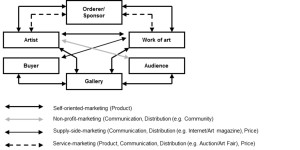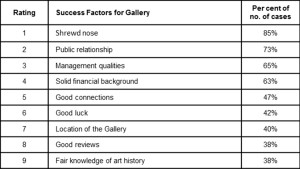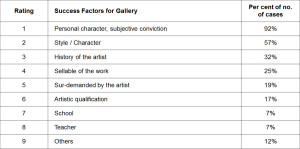While art play is personal and romantic, running an art business is often not. Calculation and business strategy count to the success of the business.
Meyer has suggested that the organization of gallery business is like a highly complicated matrix where marketing strategies become very important.

Meyer addressed this business model specifically to the operation of a gallery as he sees art products are special and different from other consumer products in the sense that consumption of artwork cannot be completed only by consumers but all surrounding parties. In other words, the selecting, marketing and selling process would not succeed if any of the parties do not share the value of the product. Thus the appreciation and marketing of an art piece requires the gallery to take into consideration all parties involved, “The usual separation of manufacturer and consumer is…not applicable to artworks. It is replaced by a unique form of collaboration in an environment” that sociologist H.S.Becker describes as the ‘art world’: “…the term ‘art world’ includes all those involved in activities – from the inception of an idea to the public reception thereof – carried out according to a certain pattern of rules and practices – mutually attuned to the production, distribution and reception of works of art”. (Becker, 1982, p.34) It is this phenomenon that makes the differences between art and other goods or services.”[1]
Not only does the consumption of art products require collaborative effort, which makes art products stands out from the general marketing spectrum, the role of galleries in the society is also changing from an art dealer to an organization in facilitating and nurturing aesthetic consumption.
The Japanese famous gallerist (小山登美夫) has well observed this phenomenon, “If art dealers are the witnesses of modernization of art, gallerists would be the followers of contemporary art. They are the controllers who discover and select artworks, reflect on social values in order to enhance values. Art dealers are comparatively more focused on sales and business by catering the tastes and following the activities of collectors, while gallerists work more on the side of artists, in a way similar to producers.” [2]
To see State-of-the-Arts Gallery’s business from this perspective, it seems that she has located quite a modern standpoint in her business maintenance: the concept of product development.
Gallery emphasizes the nurturing of artists over the initial contracting of artists; the guiding of consumers instead of delineating consumers out from certain fields. SI once remarked, “Communication comes first in art business. Artists need a focal point, a marketing position, to be able to stand in any local art market. Such focal point could be fine-tuned through genuine communication and negotiation between galleries and artists … The concept of goods selling is out, where comes the role of mediating – between all parties. Yes, the process can be slow and chances are that customers may not share the same aesthetic instinct as the artists (the gallery) at once, but the spirit of open communication, exchange of ideas, and our effort in opening up a new page of aesthetic experience for the public would be the golden rule in management and marketing of art galleries.
Appreciation, like the creation of needs from the angle of marketing, takes time and experience in individuals. Once genuine communication can be carried out, whatever initial disagreement has taken place, we can progress.”
4.2 Rationality in Art as a Business
In light of the fact that creativity is so subjective, irrational and personal, it is not uncommon for the public to see art market as random and arbitrary.
Regarding uncertainty in running an art business, Jorn-zxelmeyer and Even has carried out a research investigating the level of uncertainty in galleries, and the strategies employed to combat them.[3] In 1996, more than 2000 artists and 250 galleries for contemporary art in Germany were interviewed. They responded in the nature of uncertainty and in the solutions which shed light on a rational side of business management in the art market.

Jorn-zxelmeyer and Even asked gallery owners to rank the success factors for galleries (fig.1). Although galleries opted for a relatively abstract term “sharp nose” as the determinant factor in marking their gallery success, the planned and calculated strategies are of high importance as well: for example, public relationship and management qualities follow as the second and third important item in running art business.
Research results align with Jorn-zxelmeyer and Evan’s investigation in the criteria for galleries’ selection of artists (fig.2) below. While subjectivity comes first, gallerists attribute a high importance to other relatively objective and calculated factors as well, including style, history of the artists, and artistic qualification.

With rich marketing and sales background, Gallery shares deep resonance with Jorn-zxelmeyer and Evan’s research results on the rationality in art business management: Gallerists’ professional nose shares same importance with rational and objective strategies. Based on her arts and marketing experiences, State-of-the-Arts Gallery complemented the above figures in the selection of artists/galleries/consumers with a scorecard concept, which should apply to all parties concerned, including, galleries, artists, and consumers.
A wide range of considerations and calculations will be involved in any transaction decisions. In general, in the trading of artwork, buyers considerations involved can be broadly classified into the following three layers:
Considerations of consumers’ needs:
- Size: What size of artwork is the consumer seeking for?
- Budget: What is the consumer’s budget like?
- Style/colour: Does the consumer show any preference on colour and style of artwork?
- Subject matter: Does the consumer have any preference on the subject matter of the artwork?
Considerations of artists and art pieces:
- Artists’ philosophy: What is the message of the art piece?
- Artists’ technique: How is the message conveyed through technique?
- Subject matter: How is the message conveyed through subject matter?
- Artists’ style developmental trend/ portfolio: How is the artist’s creation style developed?
Considerations of marketing and sales values:
- Exhibition venue: Where and how is the artwork displayed?
- Platform for sale: What kind of platform (gallery, art dealer, online auction) is representing the artwork?
- Compelling issues/events: Is the artwork reflecting or working on any current issues in the society/our lives?
- Representative’s portfolio: What is the style of the representing gallery? (It hints at the style of the artwork to a certain extent)
Different parties have different weightings distributed to the above factors, which constitutes artist, consumers, and galleries individual styles and aesthetic preference. In trading artwork, the accuracy of matching different parties expectations is of paramount importance, which then lies on the extent parties understand each other. Thus genuine communications reigns.
4.3 A sharing vision – Where do we dance?
4.3.1. Market identification
Today, galleries are no longer a mere middleman for sales, but a facilitator – in sharing their aesthetic vision with the public, guiding consumers’ appreciation and consumption in artwork, together with the communication with and nurture of artists.
Probably the most difficult information retrieval in the Score-card system lies in the second layer – artists’ philosophy and artwork message. The new role of galleries then becomes important.
“We came across skillful artwork, we came across nice artists, but it is not easy to get artists who ‘speak’ – be it in artwork or in verbal communication.” As a result, the communicative power lies in artists and their works become one of the prime criteria in artists selection.
When audiences are fully entitled to their own interpretation on the art pieces, what they are also fully entitled to know for a deeper consumption before they pay to own the work is the artist’s philosophy, their vision, their messages. So, expressiveness becomes very important in artwork, at least in the contemporary pieces where conceptual and abstract art is dominant.
The more information we can get for the secondary considerations in the Score-card system, the better it facilitates the different market segments’ operations.
Before identifying where one stands in the market, one at least needs to convey what is for sale. From something as obvious as an artists’ communication with galleries and consumers, artists’ artistic technique, to something as minor as an artists’ title on their work, in fact, every process adds not only to their aesthetic expression but a market identification.
4.3.2. Artists vs. market – a fair argument?
Does consideration of the market eliminate artistic creativity and value? Should artists keep an eye on the market when creating? Can market and artistic creation co-exist in the minds of artists?
Hans, in his work “Why are artist poor” has blatantly unveiled the long-standing psychological dilemma in the art market: “Although in general the [art] market is oriented towards money and profit, the arts cannot openly reveal this kind of orientation when they operate in the market. This approach would certainly harm artistic careers and therefore, long-term incomes as well. It specifically harms the profitable affiliation of the arts with the gift sphere, and it is therefore punished by the art world. Thus, profit motives are not absent, they are merely veiled, and publicly the economic aspect of art is denied.”[4]
[4] Hans, Abbing. (2002). Why are artists poor?: the exceptional economy of the arts. Amsterdam : Amsterdam University Press.
Also, Takashe Murakami (村上隆) stands out and defends his belief in the close relationship between art and market demand in his 2006 publication.
Firstly, he pointed out the reality that artistic creation requires supporting resources, where money (which then buys time) would be one of the key sources, “When one has a lack of money, he needs to do something (get abandoned cardboard paper from the back gate of hotels to send out artwork). In that situation, no matter how he works it out, every step takes extra time to complete. Similarly, in order to shorten the time, we need the power of money. If we have money, we can buy time to save the production time cost…Art needs money and time…”
Then, he noted that to address one’s artwork with its markets needs is indeed the role of art and the responsibility of artists, “Isn’t he making brands when making artworks for sale? What is wrong? If we separate human beings’ desire from painting, one can never enjoy the happiness from it. Painting in itself is only traces of colour, which contains no value. But now, such a valueless item can be added the values of ‘human imagination’. This is to say, Art must embody inspirations for imagination.
“Whether an artwork can enhance communication is the key to success…People says ‘no good artwork can be produced by considerations of demand and supply’. Is that really the way?”
Nevertheless, he also reserves the artists’ authority and duty in the balancing market factors and artistic autonomy in transmitting individual ideas: “If we agree that art sponsors are our customers in this age, there is no question that their voices will affect artistic decisions. Artists must learn to respond after receiving customers’ demands, without forgetting to leave traces of personal judgments in the artwork. Otherwise, artists will suffer from economic hardships.” [5]
While artists may see that a consideration of the market demand for their artwork restricts and limit their artistic freedom and creativity, the scope of artistic expressiveness is in fact just so large that thinking of the market is only a starting point. Once artists identify what is worth their focus in the market, they can then move on to their own artistic language and artistic expressiveness. What’s more, when the definition of art market is not merely money value of artwork, but what the public enjoys and the reasons of enjoyment, their demand reflects what is needed for contemplation, for reflection, for giving meaning to oneself.
In other words, when art captures and reflects human experience, an understanding of how and why different artistic elements would be needed for different people, and different times and places may give direction for artistic creation. Thus the cooperation between artists and gallery would be most appropriate in investigating what their art market is, who the customers are, and what is that they need. That market space is probably exactly what artists need to know, to think about, and to transform (both their own work and their audiences) from.
4.4 Gallery Business: Professionalism, Passion, Patient
Having discussed on all the rational calculations and marketing strategies in art as business, professional sensitivity is still rated as the most crucial factor in determining business success in the art market.
As a result, it is not surprising to see sole proprietorship as the common business model of galleries, and what accompanies that is sole decision-making and risk-bearing processes. The importance of aesthetic subjectivity involved in this special business management denies possible calculation of payoff timeline or return on investment.
Just because that gallery owners’ personal artistic sensitivity is the main factor which drives the success of the business, enormous passion and belief on his business choices (the selection of artwork, identification of market segment, decision on marketing strategies and so on) would be needed to ‘cultivate’ the success.
Time and patience, is then the key for a stable position in the market, especially in markets about artistic style. It is a kind of aesthetic mindset, a kind of aesthetic viewpoint, and a certain type of aesthetic experience, which is being promoted – not a one-off product.
Despite the view on “liability of newness”, new ventures encounter many difficulties for they may lack production resources and display platform, in the art gallery business, newness is something enjoyable for the market while time and patience become critical when the gallery is working on opening up and expanding the existing aesthetic experiences of the public.
Founding an art gallery is about sensitivity and passion, and running an art gallery is about patience. From 2004 to present, we see interesting ups and downs in the number of galleries in Hong Kong. Galleries opened and closed. Patience costs.
Where comes State-of-the-Arts Gallery’s drive to patience then? Our belief in abundant supply of quality artwork, while yet limited space for their display and promotion. Art market is still of high potential.
With such a firm belief in the potential of the art market, my Gallery, established in 2003, has been expanded from an upstairs display closet to a culturally significant business in HK today, hosting a large range of exhibitions, consultancy tasks and charity activities, representing artists worldwide.